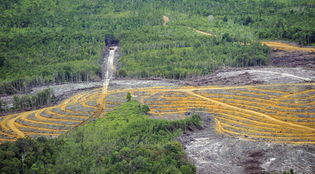 loading
loading
FindingsPalm oil and global warmingFrom Borneo’s forests to your buttercream frosting, at a cost.  AFP/Getty ImagesAbout 6,100 square miles were deforested in Indonesian Borneo for oil-palm plantations from 2000 to 2010. View full imagePalm oil is found in cookies, cleaning products, and even gas tanks, and its commercial use has expanded sharply in the last generation. Now, new Yale research has found that the rising production of this common ingredient exacts a heavy environmental toll. The study, conducted with Stanford researchers, says that oil-palm plantations in Indonesia have become a leading cause of deforestation and, therefore, of carbon dioxide emissions. Peatlands, some of them forested, are also being converted to plantations. When peatlands are drained and burned to plant oil palm, the dead wood below ground releases its carbon into the atmosphere; peatland conversion generated up to 35 percent of the carbon emissions from oil-palm plantings in Kalimantan (the Indonesian part of Borneo) between 1990 and 2010. “Areas previously planted with rubber trees and fruit gardens and forests have been converted to oil palm,” says Kimberly Carlson ’09MPhil, a PhD candidate at the School of Forestry and Environmental Studies and coauthor of the paper, which was published in Nature Climate Change. As someone who has studied biodiversity in rainforests, she finds it “a shocking thing to watch.” Palm oil supplies about 30 percent of the vegetable oil used worldwide. Indonesia produces about half the world’s palm oil and, according to the study, the country plans to double its production by 2020. Using satellite maps, the team found that between 2000 and 2010, oil-palm plantations were responsible for 57 percent of the deforestation on Indonesian Borneo—about 6,100 square miles. If all the unallocated leases are developed by 2020, the plantations will clear another 36,000 square miles, 90 percent of which is now forested. Carlson says many actors—largely private companies—are involved in the conversion of forests and peatlands to plantations. Most of the development, she adds, occurred after the Indonesian government decentralized in 2003. Nigel Sizer of the World Resources Institute says he has worked with nonprofits, industry, and government to help them easily identify already-degraded lands, instead of forests, for growing oil palm. But it’s challenging, he says, in a country with many players at the local level. “It is a fabulous crop,” Sizer says of oil palm. “The issue is where it is being planted and how it’s being managed.”
The comment period has expired.
|
|